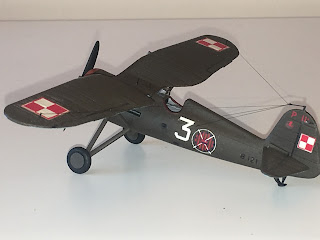Not too much is known of this fighter/observer aircraft, but I had the Windsock Mini Datafile 4 on this peculiar aircraft. The pulpit aircraft had the engine mounted between the pilot and the observer, which meant that even a minor accident would risk the life and well being of the observer as he'd be pinned down by the engine. During test flights, the actual pulpit even came off at altitude. On the bright side, the aircraft was stated to be easy to fly, fast, and with excellent visibility for the observer.

The exact date of the maiden flight is unknown, but it may have been May 21, 1915. No entire escadrilles were uniformly equipped with S.A-2 or S.A-4 Spad-Bechereau, and they were dispersed in small numbers among various units. On February 1, 1916, only four were listed as being at the front and five in the unspecified interior. In all 42 SPAD S.A. aircraft were acquired by the Aviation militaire, and a further 57 S.A-2s were purchased by Russia. Eleven SPAD S.A-4s were built, and ten of them went to Russia. The S.A-4 had a 110 hp engine instead of an 80 hp, and it also only had ailerons on the top wings, besides some minor differences. The first S.A-4 flew on February 22, 1916. The Russians used the S.A until the end of the war, and some may even have been used by the Soviets. Actual combat records are scarce.
The kit is a Russian A-Model short-run injection-moulded model kindly given to me as a gift by Lt Col Marc Forterre of the French Army. I started off by washing the sprues in mild detergent to get rid of any remaining release agents, and then I proceeded to trim off quite a bit of flash while sorting the 41 parts after the instruction steps. The plastic is hard and brittle, so care and a fresh X-Acto blade was required, and yet several thin parts had to be replaced by scratch-building. I added a pilot and an observer from the spares box and scratch-built a semblance of a rotating propeller out of clear plastic from a lettuce container. The proportions and scale matched the drawings in Cheesman's classic on WW1 aircraft, and with that, I proceeded to the building phase. The nacelle came together smoothly, and with some trimming the observer found his place up front. The main fuselage, including cockpit and pilot, was the next step, and it came together nicely with some sanding afterwards. The tailplane was added, and then painting ensued. I used Vallejo colors, mainly tan and sand yellow, which seems to be a good match. Struts and landing gear were painted in natural wood composed of dark flesh, red brown and burnt umber with some orange-yellow mix diluted to simulate varnish. Mild weatheruing and castor oil stains were also added. Decals came next, and they were in fine form, although very thin. The detailing on the parts is restrained but sharp, and the only real problem was fitting the wings, which unfortunately led to some glue damage that hopefully isn't too visible. The nacelle was mounted, and so was the Lewis gun, stretched sprue rigging, and finally a stand made out of a wire hanger. The S.A.2 then proceeded to hunt the skies of my modelling cabinet.
A more comprehensive Review can be found here: http://www.internetmodeler.com/2004/january/aviation/meb_spad.php



















































